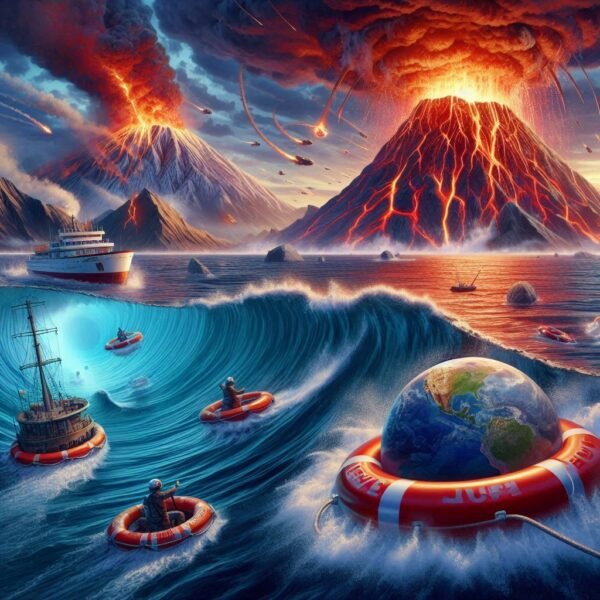Future Major Earthquakes, Volcanoes and Tsunami Warnings in 2025?

Recent developments regarding potential major earthquakes, volcanic activity, and tsunami warnings in 2025 highlight significant geological concerns, particularly in Japan and other regions.
Earthquake Predictions
Nankai Trough Megaquake Risk: As of January 16, 2025, Japan’s government has raised the probability of a magnitude 8 or 9 megaquake occurring in the Nankai Trough to 80% within the next 30 years. This revision follows a recent M6.8 earthquake near Kyushu, which is part of ongoing seismic activity in the area. The Nankai Trough is a critical subduction zone that has historically produced devastating earthquakes and tsunamis.
Recent Earthquakes: On January 7, 2025, a significant M7.1 earthquake struck Xizang (Tibet), resulting in at least 95 fatalities and affecting neighboring regions including Nepal and Bhutan. This event aligns with predictions of increased seismic activity for the year.
Volcanic Activity
Potential for Increased Seismic Activity: Reports indicate that specific planetary alignments occurring around January 23-25 may lead to heightened seismic activity globally. Areas of concern include Southern California and the Cascadia Subduction Zone, where historical data suggests significant earthquakes could occur.
Tsunami Warnings
Tsunami Preparedness: While there are no immediate tsunami warnings following recent seismic events, the Japanese government has emphasized the importance of preparedness for potential tsunamis resulting from future megaquakes in the Nankai Trough. The last major event in this region could produce waves over 100 feet tall, with catastrophic consequences.
2025 is marked by heightened awareness and concern regarding seismic risks, particularly in Japan’s Nankai Trough region, alongside broader predictions of natural disasters globally. Preparedness measures are crucial as these geological phenomena pose significant threats to affected populations.
In 2025, several significant geological events are anticipated, particularly concerning earthquakes, volcanic activity, and tsunami warnings.
Major Earthquake Events
Japan: On January 13, 2025, a magnitude 6.6 earthquake struck southwestern Japan, specifically near Miyazaki. This event triggered tsunami advisories in the region, which were later lifted. The earthquake’s depth was approximately 18.6 miles, and while there were no immediate reports of severe damage, residents were advised to evacuate coastal areas due to the potential for aftershocks and landslides.
Ongoing Risks: Japan is situated along the “Ring of Fire,” making it prone to seismic activity. Experts have noted that the region is susceptible to larger quakes, especially related to the Nankai Trough, which has a history of significant seismic events.
Volcanic Activity Predictions
Axial Seamount: A noteworthy prediction for 2025 involves the Axial Seamount, an undersea volcano located about 470 kilometers off the Oregon coast. Scientists have observed signs indicating that an eruption could occur sometime in 2025. These signs include ground deformation and increased seismic activity associated with magma accumulation beneath the surface. The volcano has been closely monitored for over a decade, and recent patterns suggest it may erupt as early as this year.
Significance of Monitoring: The ability to predict such an eruption with considerable lead time is unprecedented and represents a major advancement in volcanic forecasting. Researchers utilize real-time data from sophisticated monitoring equipment installed on the seafloor.
Tsunami Warnings
While specific tsunami warnings are often issued in response to significant earthquakes, the recent quake in Japan serves as a reminder of the potential for tsunami threats following seismic events. The January earthquake resulted in a temporary tsunami advisory with waves reaching heights of up to 3.2 feet.
The need for preparedness is emphasized by past events such as the Hunga Tonga-Hunga Ha’apai eruption in 2022, which caused widespread tsunamis across the Pacific Ocean.
General Predictions for Natural Disasters in 2025
Broader predictions for 2025 include potential increases in natural disasters linked to climate change, such as severe floods and earthquakes. Notable figures like Nostradamus have made cryptic predictions about natural calamities occurring this year, suggesting a correlation between environmental changes and geological activity.
2025 is shaping up to be a year of significant geological activity with potential earthquakes and volcanic eruptions likely influencing coastal regions and necessitating ongoing monitoring and preparedness efforts.
As of January 22, 2025, several significant seismic and volcanic events have occurred, with more anticipated throughout the year. Here’s an overview of recent events and forecasts for the remainder of 2025:
Recent Significant Events:
January 7, 2025 – Tibet Earthquake: A magnitude 7.1 earthquake struck near Shigatse, Tibet, resulting in at least 95 fatalities and 130 injuries. The quake caused extensive damage to approximately 1,000 houses.
January 13, 2025 – Southwestern Japan Earthquake: A magnitude 6.9 earthquake occurred off the coast of southwestern Japan, prompting a tsunami advisory that was later lifted. The quake caused minor injuries and infrastructure damage.
January 22, 2025 – Kamaʻehuakanaloa Volcano Activity: In Hawaii, increased seismic activity was detected at the Kamaʻehuakanaloa volcano, with over 70 earthquakes recorded, including two exceeding magnitude 4.0. This suggests potential volcanic activity in the near future.
Forecasts and Warnings for 2025:
Axial Seamount Volcano: Researchers from Oregon State University predict that the Axial Seamount, a submarine volcano off the coast of Oregon, may erupt at some point in 2025. This prediction is based on observed swelling of the volcano’s surface, similar to patterns before its last eruption in 2015.
Manila Trench Tsunami Hazard: Studies have forecasted the potential for a massive tsunami originating from the Manila Trench, which could affect regions including Taiwan, the Philippines, and parts of Southeast Asia. The predicted tsunami could reach the southern coast of Thailand in approximately 13 hours and Bangkok in 19 hours.
Tsunami Warning Resources:
For real-time tsunami alerts and information, the U.S. Tsunami Warning Centers provide comprehensive updates. While primarily focused on U.S. regions, their data can be valuable for understanding global tsunami threats.
Safety Recommendations:
Stay Informed: Regularly monitor official sources such as the U.S. Tsunami Warning Centers and local geological agencies for updates on seismic and volcanic activity.
Emergency Preparedness: Familiarize yourself with evacuation routes and emergency procedures, especially if you reside in or plan to visit areas prone to earthquakes and tsunamis.
Use Technology: Consider utilizing tsunami tracker apps and services to receive timely alerts and information. For instance, the FEMA app offers customizable alerts and real-time notifications, though it is primarily available for U.S. locations.
While it’s impossible to predict exact dates and locations of future major earthquakes, volcanoes, and tsunamis, staying informed and prepared is crucial for safety. There is no way to predict future earthquakes, volcanoes, or tsunamis with certainty. However, scientists can identify areas that are at high risk for these events.
Some of the areas that are considered to be at high risk for earthquakes include:
The Pacific Ring of Fire, which is a zone of volcanic and seismic activity that surrounds the Pacific Ocean.
The Alpine-Himalayan belt, which is a zone of seismic activity that runs through Asia and Europe.
The Middle East, which is a region with a history of large earthquakes.
Some of the areas that are considered to be at high risk for volcanic eruptions include:
The Pacific Ring of Fire.
Iceland, which is a volcanic island in the North Atlantic Ocean.
Italy, which is home to several active volcanoes.
Some of the areas that are considered to be at high risk for tsunamis include:
Coastal areas near active volcanoes or earthquake zones.
The Indian Ocean, which was the site of a devastating tsunami in 2004.
The Mediterranean Sea, which has a history of tsunamis.
It is important to be prepared for these events, even if you do not live in a high-risk area. You can find information on how to prepare for earthquakes, volcanoes, and tsunamis on the websites of the National Oceanic and Atmospheric Administration (NOAA) and the United States Geological Survey (USGS).

